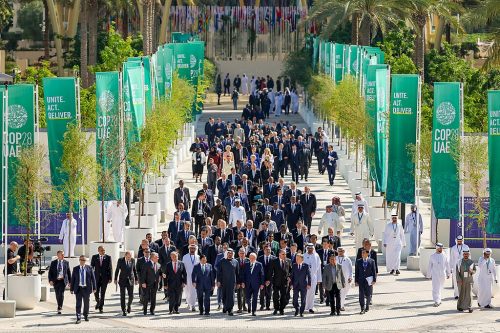Dubai —(Map)
Since last Thursday, representatives of hundreds of nations have been talking at an important climate meeting in Dubai. There has been progress, but there are also challenges. The biggest question is whether to end fossil fuels or just reduce them.
Climate Crisis
Since people first began burning coal to run factories, the world’s temperature has gone up by about 1.2 degrees Celsius (C)**. This increase has led to serious long-term changes in weather patterns that affect all life on Earth.
The world is getting hotter, mainly because humans are burning “fossil fuels” like coal, oil, and natural gas to make energy. These fuels give off pollution called “greenhouse gases” or “carbon emissions”, which make the climate emergency worse.
The effects of climate change can already be seen: melting ice in Antarctica and the Arctic, higher temperatures, heat waves, droughts, wildfires, record rains, and more strong hurricanes.
Scientists say the world must take strong action before 2030, and limit global warming to 1.5ºC to avoid the worst effects of the climate crisis.

(Source: Republic of Maldives, President’s Office [CC BY 4.0], via Wikimedia Commons.)
In 2015, the world’s countries signed the “Paris Agreement” to work together to try to limit global warming to 1.5ºC. In recent years, world leaders have held follow-up meetings like COP26 and COP27.* The meetings are meant to check in on how the world is doing in its fight against the climate crisis, and to reach agreements on next steps.
This year’s meeting, COP28, is being held in Dubai, United Arab Emirates (UAE). One of the big questions about COP28 is whether countries will agree to stop producing oil and gas (called a “phase-out”), or will simply agree to produce less (a “phase-down”).
Most experts agree that to limit global warming as much as possible, the world needs to end the use of coal and oil. Over 100 countries say that COP28 should lead to a deal to phase out fossil fuels. “The science is clear,” said UN leader Antonio Guterres, “The 1.5 degree target is only possible if we finally stop burning fossil fuels.”
😕
This image has not been loaded because of your cookie choices. To view the content, you can accept 'Non-necessary' cookies.
Over 100 countries say that COP28 should lead to a deal to phase out fossil fuels. But the UAE is a major oil producer. And the president of this year’s meeting, Sultan Al Jaber (above), leads the UAE’s largest oil company. Many people say that Mr. Jaber isn’t the right choice to lead the meeting.
But the UAE is a major oil producer. And the president of this year’s meeting, Sultan Al Jaber, leads the UAE’s largest oil company. Many people say that, because of his connections, Mr. Jaber isn’t the right choice to lead the meeting.
Even before the meeting began, there were reports that the UAE was using COP28 to try to make deals to sell more oil. On Sunday, a video came out showing Mr. Jaber claiming there was “no science” supporting a phase-out of fossil fuels, which isn’t true. Mr. Jaber denies that the UAE is using COP28 to make oil deals. He also says his comments were misunderstood. “We very much believe and respect the science,” he said.
In spite of the disagreements, some progress is being made. One important step is a deal to set aside a large amount of money (a “fund“) to help the countries being hit hardest by climate change. Most of the money would come from richer countries, which have created a lot of the pollution that led to the climate crisis.
😕
This image has not been loaded because of your cookie choices. To view the content, you can accept 'Non-necessary' cookies.
The meeting reached a deal to set aside money to help the countries hit hardest by climate change. Many affected countries are in the southern part of the world. Above, Brazilian President Luiz Inacio Lula da Silva speaks at the meeting. Mr. da Silva suggested a plan to protect rainforests.
A number of countries have also announced that they’re putting huge amounts of money toward tackling the crisis. For example, UAE says it’s putting $30 billion toward climate action. But big promises have been made at previous COP meetings, and not all of those promises have been kept.
Progress on controlling the dangerous greenhouse gas methane is probably COP28’s biggest success so far. The US has announced a plan to cut methane pollution by 80% over the next 15 years. Many other countries are working on similar programs. Cutting methane pollution will have a rapid and powerful effect on global warming.
COP28 is just in its first week, and the meeting will continue until December 12. Many people are hoping for a lot more progress over the next seven days.
* COP stands for “Conference of the Parties”, which basically means “Meeting of the countries that signed the agreement”. In this case, the agreement is the 1992 United Nations Framework Convention on Climate Change. This was the 28th meeting since the agreement was first signed.
** Climate change temperatures are measured against the time when humans started burning coal for power. This article talks about climate change using Celsius (C). Talking about climate change in Celsius is more common and it makes the changes easier to see and remember.
If you want to think about the temperature changes in Fahrenheit( F), you can use these figures: 1.2ºC = 2.16ºF, 1.5°C = 2.7°F, 2°C = 3.6°F.
😕
This map has not been loaded because of your cookie choices. To view the content, you can accept 'Non-necessary' cookies.
